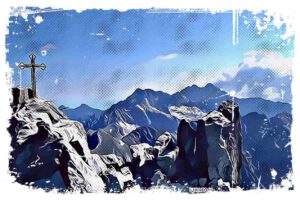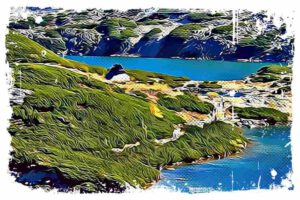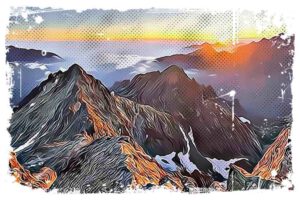If you’re planning a bike trip around the Tatra Mountains, it’s essential to prepare well in advance. You’ll be facing increased physical effort and sometimes unpredictable weather conditions like heat or rain showers. Mountain areas can be tricky, even in summer, with sudden storms, rain, or poor visibility.

But with careful planning and preparation, you’ll be able to enjoy every kilometer of this unique adventure. In this post, I’ll guide you on how to prepare for your bike journey around the Tatra Mountains, including choosing the right bike and equipment, understanding cycling regulations in Poland and Slovakia, and packing the essentials. Some tips may seem obvious, but they’re all worth knowing to avoid stress later on. After all, this should be a beautiful and unforgettable experience.
If you are curious about my own trip, please read more here: The Tatra Mountains Bike Trail Guide – The Ride I Will Never Forget
1. Boost Your Physical Fitness
I believe that the first step to getting ready for your bike trip around the Tatra Mountains is improving your physical fitness. To do this, ride your bike to work, get off the bus a couple of stops early, or go for a run. Cycling or running at least three times a week will boost your stamina and enhance your performance. Being physically fit will reduce your risk of injury and prevent your muscles from giving up after just 10 kilometers.
↳ Before you head to Tatra Park, I highly recommend reading my complete guide to Tatra Mountains. I showcase the most scenic places you won't want to miss. Make sure to check it out, so you don't overlook anything interesting: Tatra Mountains – An Insider’s Guide to All Attractions and Info
If you’re more of a couch potato, and regular exercise isn’t your thing, I suggest breaking down the Tatra Mountain bike route into shorter, less challenging sections. But don’t skip them altogether!

From my experience, I recommend starting with the first part of the route from Nowy Targ to the Polish-Slovak border or further to the Slovak Trstená (35 km). This section follows a flat, asphalt bike path that’s separate from car traffic, making it perfct for beginners. Plus, you’ll find plenty of bus shelters along the way to rest and regain your energy.
2. Map Out Your Journey
The historic, cultural, and natural bike route around the Tatras takes you through the Tatra lands of Podhale, Orawa, Liptov, and Spisz in Poland and Slovakia. It starts and ends in Nowy Targ, passing through picturesque towns and villages, stunning landscapes, and numerous attractions that showcase the rich tradition and culture of the Polish-Slovak borderland. Currently, the Tatra Mountain Route covers over 150 km out of the planned 250 km.
If you’re in good shape, you should be able to complete the entire trail in 2-4 days. Some seasoned cyclists even manage to cover the whole route in just one day, but that requires a high level of fitnes, experience, and commitment.
If you don’t feel up for tackling the entire 250 km, choose one of the scenic sections of the trail instead. You can also visit the official website of the Historical, Cultural, and Natural Trail around the Tatra Mountains, which offers recreational bike routes for everyone.

Before you set off, make sure you understand the difficulty, length, and estimated time for each section of the trail. Be realistic about your abilities, and remember that technical difficulty isn’t everything. If you’re feeling tired, don’t push yourself too hard.
You may also want to read this article: Driving Around Tatra Mountains – My Unforgettable Road Trip
Take regular breaks to rest, recover, and replenish electrolytes. Allow time for sightseeing, taking photos, and enjoying the breathtaking views that abound along the route.
Always have a backup plan in case of bad weather or injury. Keep the contact information for bike rentals and services handy in case of technical issues with your bike. In our opinion, it’s not necessary to book accommodations in advance. Instead, make a list of available lodging options along the route so you can easily adjust your plans if needed. If you’re bringing a tent and planning to stay at campsites, you’ll have even more flexibility to change your itinerary and spend the night at different locations.
Pro tip: Use Komoot or Google Maps to plan your route. Komoot is especially great for bike trip planning, as it shows not only the route length but also the travel time based on your cycling proficiency. It also displays elevation changes, road types, nearby attractions, and other useful information. The app is built on OpenStreetMap and includes sections contributed by other users. Plus, it saves your traveled route by recording your track, so you can easily recreate it later with detailed data. The basic version of Komoot is free, but we recommend the paid version (about 30 Euro) for additional features like navigation along planned routes, trip saving, and offline maps on your phone.
3. Choose the Right Bike and Cycling Gear
a) Bicycle
To fully enjoy your trip along the Tatra Mountain Route, you need the right type of bike. A city bike just won’t cut it! A cross bike is the best choice as it can handle both asphalt and gravel roads. For those with lower physical fitness, e-bikes with electric asistance might be a good alternative. I don’t recommend mountain cross bikes, since the trail mainly consists of asphalt surfaces, and you’ll only tire yourself out.

For our Tatra Mountain adventure, we used these cross bikes:
- KTM Ultra
- UNIBIKE Emotion
b) Mandatory Cycling Equipment
To comply with regulations in Poland and Slovakia, you must have the following bicycle equipment:
- Front light – white or yellow light, steady or flashing. In Slovakia, a white reflective light is mandatory!
- Rear light – red reflective light (not triangular) and a red position light (can be flashing). Bike lights must be attached at a height between 25 cm and 150 cm from the road surface.
- Brakes – at least one working brake in Poland. In Slovakia, two efficient and independent brakes are mandatory!
- Bell – with an optimal signal
- Helmet – recommended in Poland, mandatory in Slovakia!
- Reflective vest or reflective elements on clothing – mandatory in Slovakia if you’re riding a bike
c) Additional Cycling Equipment

Besides the mandatory gear, consider adding these items to enhance your trip’s comfort:
- Saddle – make sure it’s comfortable and test it beforehand.
- Handlebars – opt for ones with horns or a butterfly shape. This allows you to change your grip during the ride and provides comfort to tired hands and arms.
- Bike rack – check its maximum load capacity (minimum of 25 kg) to easily carry a backpack or mount panniers.
- Bike bags – you’ll likely need bags for a multi-day trip. I used two 25 L waterproof bags for each bike, plus a 7 L photo bag with a waterproof cover attached to the handlebars for documents and snacks.
- Waterproof phone cover with navigation/map – essential for safely following the route.
- Mudguards – in hindsight, we believe these are unnecessary and only add extra weight.
- Water bottle – water bottles, which feature a magnetic-mechanical system for easy attachment and detachment.
- Basic toolset – matched to your bike for minor repairs on the go.
- Patch kit or spare inner tube – punctures are common, so bring a spare tube to avoid searching for a repair shop.
- Bike pump
- Bike lock
d) Bicycle Rentals
No bike? No problem! In larger Polish cities, Nowy Targ, and the surrounding areas, you’ll find numerous bicycle rental shops. Some even offer free parking for renters during their trip. Make sure to book your rental in advance and ask about the possibility of testing the bike before setting off on a longer route.
Remember, the bike must be adjusted to your height! It’s also a good idea to test the saddle beforehand, as it may require additional adjustment. For more information on bike rentals in Nowy Targ and nearby areas, visit the official website of the historical, cultural, and natural trail around the Tatra Mountains.
Bike and equipment rental prices:
- Cross bike – from PLN 60/day, from PLN 100/2 days
- Electric bike – from PLN 100/day and over PLN 180/2 days
- Bike pannier – from PLN 25/day and PLN 40/2 days
One rule applies – the longer the rental period, the cheaper it is.
NOTE: Unfortunately, there is no insurance option for rented bikes in Poland. Rental companies will not provide this service. The most you can get from them (sometimes for an additional fee) is a bike lock. When renting a bike, you are fully responsible for its theft. So, always keep an eye on your bike and don’t leave it unattended!
e) Bicycle Maintanance
Before embarking on your bike trip, make sure to check the technical condition of your bike. If you own a bike but are unsure whether its condition is suitable for the Tatra Mountain Route, take it to a bicycle service shop.
Additionally, if you encounter issues along the route, there are several service points and numerous self-service mini service stations on both the Polish and Slovak sides of the Tatra Mountain Route, where you can handle minor repairs.
4. Complete Your Inventory
You’ve planned your route and prepped your bike. Now it’s time to pack. You might be wondering what to take with you on a bike trip. For a short one-day trip, a small backpack of about 10-20 liters should suffice.
Avoid using any kind of bags or plastic bags! For a multi-day trip, opt for waterproof panniers instead of a backpack, in which you can pack clothes and toiletries. The size and type of panniers depend on individual preferences. For our 4-day trip, two 25L panniers and a 7L handlebar bag were sufficient.
What to pack for a bike trip?

I. Backpack/handlebar bag essentials
- Identity card/passport – necessary when crossing the Polish-Slovak border
- Money – remember that the currency in Slovakia is EUR! Also, carry some zlotys, as many food establishments on the Polish side of the trail don’t accept card payments!
- A paper card with the bike rental/service station number – in case of technical issues with the bike
- A charged phone and an additional power source – a power bank with a cable
- A paper map – an alternative to phone navigation
- Water, water, and more water!
- Energy-boosting snacks (candy, chocolate, energy gels, bananas, etc.)
- Headlamp – in case of issues with bike lights
- Mini first aid kit with basic painkillers, dressing, plasters, elastic bandage, and sterile dressing.
- Sunscreen – the sun can be intense in the mountains. Good sunscreen is recommended year-round!
- Sunglasses
- Photographic equipment
- Disposable mask
II. Pannier essentials:
- Rainproof jacket and pants – they don’t take up much space and will protect you from the rain! Remember, mountain weather can change quickly.
- Thermoactive clothing and underwear – long and short sleeve T-shirts, underpants, boxer shorts, bras, women’s tops, socks, etc., made of sweat-wicking material. Cotton T-shirts become heavy when wet and take a long time to dry on the body.
- Sleeping clothes
- A change of shoes (!) – we had only one pair of shoes (excluding flip-flops for the shower) on our 4-day trip, and when we got caught in the rain, we regretted not bringing sandals! We had to dry our wet shoes using the hotel dryer!
- Quick-drying towel
- Toiletries – preferably small, travel-sized ones to save space
- Cycling gloves – protect your hands from falls and abrasions while riding
- Cycling shorts – shorts with foam inserts that absorb vibrations and prevent chafing. We didn’t personally use them, but many cyclists swear by them.
- Softshell or fleece – useful for colder, windy, and rainy days
- Phone/camera charger
- Tent, sleeping bag, self-inflating mat, gas cooker, cutlery, mug, canteen – if you plan to stay at campsites
- Nutella Jar – I always have it on me 🙂

5. Check the Weather and Pedal at the Right Time of Day
Preparing for a bike trip also involves checking the current weather forecast. If storms or intermittent rain are predicted, it’s essential to pack waterproof clothes to avoid getting cold. Surprisingly, beautiful sunny weather and intense heat can also make a trip challenging.
For More information read this article: The Best Times of Year and Weather to Visit the Tatra Mountains
During physical exertion, our body temperature rises, which in hot weather can lead to weakness or even fainting. Remember to always stay hydrated and take frequent breaks! About 30 rest areas in the form of comfortable bus shelters have been set up along the Route Around the Tatra Mountains. They also provide excellent protection from the rain.
Tip : You can find current weather forecasts at yr.no and meteo.pl. If possible, start your trip in the morning, and when temperatures peak, spend that time resting, eating, or sightseeing instead of pedaling.
6. Familiarize Yourself With Cycling Regulations
According to existing regulations, a cyclist is a legitimate participant in road traffic just like car drivers and motorcyclists. To safely navigate the roads and not pose a danger to others, you must adhere to the applicable laws.
Preparation for a Bike Trip – General Cycling Regulations in Poland and Slovakia
Cyclists are obliged to:
- Observe right-hand traffic
- Use bike lanes, if available
- Signal a change of direction with an outstretched hand
- Keep at least one hand on the handlebars and one foot on the pedals
- Maintain a safe distance from other cyclists
- Dismount at pedestrian crossings and walk the bike across lanes, unless a bike crossing is marked on the lanes
- Remain sober!
In Poland, riding side-by-side is allowed only on roads with light traffic, while in Slovakia, it’s permitted only on bike lanes when it doesn’t pose a threat to other cyclists. Leading a dog or a second bike while riding is prohibited. In Slovakia, zones marked with „Pešia zóna” require yielding to pedestrians.
A child up to 7 years old can be transported in a car seat. If the child weighs less than 15 kg, the seat can be attached to the frame; if they weigh no more than 22 kg, the seat must be mounted behind the saddle. Children under 10 must be supervised by adults during bike trips. Exceptions include bike lanes, field roads, forest roads, designated residential areas, and pedestrian sidewalks. Riders aged 10-18 should possess a bicycle card.
7. Know The Trail Markings
The Bicycle Trail Around the Tatra Mountains is marked with orange metal plates featuring the trail logo. The main route displays a color logo, while side routes, connectors, and loops have a black and white logo. Some signpost boards also indicate distances to interesting towns, attractions, and resting places along the trail.

On the Slovak side, trail markings, in addition to metal plates, often take the form of the letter C drawn on trees, poles, or asphalt and come in 5 colors, representing:
- black – easy, educational bike paths
- yellow – easy bike paths and access between paths, as well as access to tourist attractions
- green – moderately difficult bike paths, health-promoting bike loops, and family-friendly paths
- blue – longer bike paths of moderate difficulty, often equivalent to EuroVelo trails
- red – long EuroVelo routes spanning multiple countries
Besides the colors on the markings, you can also find distances to individual towns on the route and whether the path leads uphill or on flat terrain.
8. Observe Cycling Savoir Vivre
Just like in everyday life, savoir vivre applies to bike paths. Being courteous costs nothing and enhances the safety and comfort of your journey. Here are a few rules that everyone who gets on a bike should follow:
- Familiarize yourself with the basic signs and rules of the road
- Always signal your maneuvers
- Do not overtake at intersections
- Don’t block the road
- Overtake carefully and only when you have enough space
- Remember the purpose of the counter-lane and don’t ride against the flow!
- Be understanding – you are not the only one on the path
- Collaborate with drivers and other road users
- Don’t rest in the middle of the bike path, move to the side!
- Don’t block the entire width of the path
- Remember that you are a guest on the sidewalk
- Wear a helmet
- Use reflectors and lights after dark
- Be kind, smile, apologize, and thank
References:
- https://www.centrumrowerowe.pl/blog/przepisy-rowerowe/
- https://www.szlakwokoltatr.eu/
- https://tpn.pl/zwiedzaj/turystyka/turystyka-rowerowa



